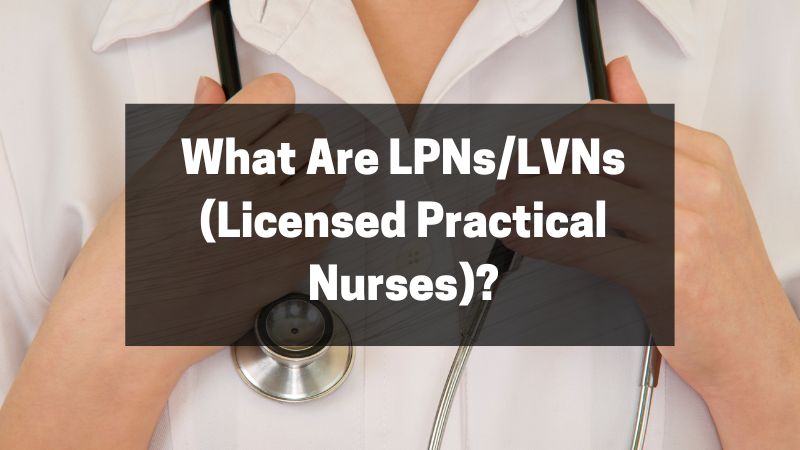Are you interested in becoming a nurse but still trying to find out which type of nurse you want to become?
Have you heard of Licensed Practical Nurses but don’t exactly know what they are or what they do?
Well, you’ve come to the right place!
Here, we will give you everything you need to know about LPNs/LVNs!
We’ll answer the following questions:
What Are LPNs/LVNs (Licensed Practical Nurses)?
What Do LPNs/LVNs Do?
What is the Difference Between an LPN and an LVN?
What’s the Difference Between an LPN/LVN and an RN?
Where Do LPNs/LVNs Work?
What Qualities Should LPNs/LVNs Have?
Do LPNs/LVNs Have Good and Viable Careers?
How Do I Become an LPN/LVN?
How Can LPNs/LVNs Advance Their Careers?
How Much Do LPNs/LVNs Earn?
Answering these questions will give you a grasp of what being an LPN entails and if it’s the right career path for you.
Let’s begin!
What Are LPNs/LVNs (Licensed Practical Nurses)?
Licensed Practical Nurses (also called ‘Licensed Vocational Nurses’ in some states) are nurses who provide basic medical care for patients, such as checking their vital signs and monitoring their condition.
They work under the supervision of registered nurses (RNs) and physicians and serve as a line of communication between patients, their families, and the healthcare team.
What Do LPNs/LVNs Do?
The exact scope of what an LPN does may vary per state.
Some states allow LPNs to handle IV insertions and medications, while others don’t. Some allow LPNs to draw blood, but the exact rules for this may vary.
LPNs should know their scope of practice in their state very well.
However, as a general guide, LPNs are generally expected to do the following:
Check the vital signs of the patients (such as blood pressure and body temperature)
Keep detailed records of the patient’s health, including food and fluid intake and output
Report the health status of patients to doctors and other healthcare providers
Communicate with the patients and their families
Ensure the patients’ comfort by helping with bathing, dressing, feeding, applying a hot or cold compress, giving massages, etc.
Change bandages, insert catheters, and treat bedsores
Collect samples for testing
Supervise Clinical Nurse Assistants
Administer prescribed medications and start IV infusions (in the states that allow LPNs to do this)
What is the Difference Between an LPN and an LVN?
Licensed Practical Nurses (LPNs) and Licensed Vocational Nurses (LVNs) are basically the same types of nurses.
They take the same licensing exam and perform the same types of duties in the workplace.
The only difference is that the term LVN is officially used in both California and Texas.
What’s the Difference Between an LPN/LVN and an RN?
Both LPNs and RNs are licensed nurses who have to go through nursing education programs and have to take national exams.
However, LPNs have shorter and less rigorous training than RNs, and therefore don’t have the full scope of practice that RNs have. LPNs work under the supervision of RNs.
LPNs provide more basic medical care to patients, such as checking vital signs and changing wound dressings. RNs, on the other hand, may have more complex and managerial roles, such as creating care plans and administering tests and treatments.
Both roles are very important in overall patient care.
Where Do LPNs/LVNs Work?
LPNs can work in many different healthcare settings, such as:
Nursing homes and long-term care facilities
Private homes (or home health care)
Hospitals
Physician’s offices
Government and military facilities
Most of the time, LPNs are found in nursing homes and other long-term care facilities like hospices.
They provide day-to-day assistance to the patients and help them to care for themselves. They also monitor their health to be able to report to their primary care physicians.
They can also provide home health care by visiting patients’ homes daily or weekly.
Hospitals mostly hire RNs, although some may still hire LPNs as well.
In physician’s offices, LPNs may take your vitals and other information before the doctor comes in to examine you.
LPNs can also be found in other settings, such as schools, charities, research centers, etc.
What Qualities Should LPNs/LVNs Have?
LPNs work very closely with patients and provide basic care to them. They should, therefore, have a good bedside manner and should be compassionate and comforting.
They should also be able to communicate clearly to the patients and their families about the care they are receiving. They must also be able to communicate effectively and thoroughly the health status of the patients with the RNs and doctors.
LPNs should be organized and efficient since they are working in a fast-paced and demanding environment. They should be able to multitask.
Just like other medical professionals, they should be able to tolerate the sight of blood and other body fluids, since they will be helping patients with bathing, wound dressing, blood extractions, etc.
Do LPNs/LVNs Have Good and Viable Careers?
According to the Bureau of Labor Statistics (BLS), the employment of LPNs is expected to grow by 6% from 2021-2031.
This means that there will be about 58,800 job openings for LPNs every year throughout the decade.
Most of the employment of LPNs will happen in residential care facilities and home health care, mostly dealing with elderly patients.
As the older population ages and more chronic diseases come out (such as diabetes and heart conditions), there is a need for more LPNs to assist the elderly.
However, since LPNs have a limited scope of practice, they may have limited opportunities for career advancement or promotions.
They can improve their credentials by taking additional certifications, or they can proceed later on to become an RN.
Becoming an LPN is a great stepping-stone to more advanced nursing professions if you choose to advance your career.
How Do I Become an LPN/LVN?
The first step to becoming an LPN is to enroll in an accredited nursing education program. These programs are usually offered in community colleges or vocational schools.
The program usually takes 1 year to complete and it contains two main parts - academic or classroom instruction and clinical training.
After completing your program, you will need to take and pass a national examination for all aspiring LPNs (the NCLEX-PN). You will also need to apply for a license from your state’s board of nursing.
If you pass the exam and all your documents are approved by the board of nursing, then you will receive your license.
You will need to keep this license updated or renewed to be able to continue practicing as an LPN.
You can read a more detailed article about how to become an LPN here.
How Can LPNs/LVNs Advance Their Careers?
There are certification programs that LPNs can take to improve their credentials and advance their careers.
Some certifications they can look into include:
Patient counseling certification
Intravenous (IV) therapy certification
Advanced life support certification
Long-term and hospice care certification
Cardiopulmonary resuscitation (CPR) training
Certified Hemodialysis LPN
Certified Peritoneal Dialysis LPN
Developmental Disabilities LPN
Transplant Coordinator LPN
Urology LPN
Wound Care LPN
Aside from certifications, LPNs can consider taking a bridge program to become an RN. Several schools offer shorter routes for LPNs to finish an ADN or a BSN program.
How Much Do LPNs/LVNs Earn?
According to the BLS, LPNs earn an annual mean wage of $ 51,850.
The top-paying industries for LPNs are personal care services, office administrative services, insurance carriers, health and personal care stores, and junior colleges.
Industry | Employment | Percent of industry employment | Hourly mean wage | Hourly mean wage |
|---|---|---|---|---|
Personal Care Services | 150 | 0.02 | $31.18 | $64,840 |
Office Administrative Services | 1,370 | 0.28 | $30.93 | $64,330 |
Insurance Carriers | 620 | 0.05 | $28.73 | $59,770 |
Health and Personal Care Stores | 100 | 0.01 | $28.65 | $59,590 |
Junior Colleges | 90 | 0.01 | $28.56 | $59,400 |
The top-paying states for LPNs are California, Alaska, Washington, Massachusetts, and Nevada.
State | Employment | Employment per thousnad jobs | Location quotient | Hourly mean wage | Annual mean wage |
|---|---|---|---|---|---|
California | 72,180 | 4.37 | 0.96 | $31.32 | $65,140 |
Alaska | 480 | 1.61 | 0.35 | $30.60 | $63,650 |
Washington | 7,110 | 2.22 | 0.49 | $30.41 | $63,250 |
Massachusetts | 15,500 | 4.57 | 1.00 | $29.72 | $61,820 |
Nevada | 3,610 | 2.80 | 0.61 | $29.08 | $60,490 |
In Summary
We’ve seen what an LPN is, what they do, how they are the same as LVNs, how they differ from RNs, where they work, how much they earn, etc.
These are all important pieces of information for you to have a better grasp of what it means to be an LPN.
We hope that you will find this helpful for you to decide whether you want to become an LPN or not.
We wish you the best on your nursing journey ahead!

